 |
Current Conditions
| Tropical Pacific Sea Surface Temperatures | Tropical Pacific Sea Surface Temperature Anomalies |
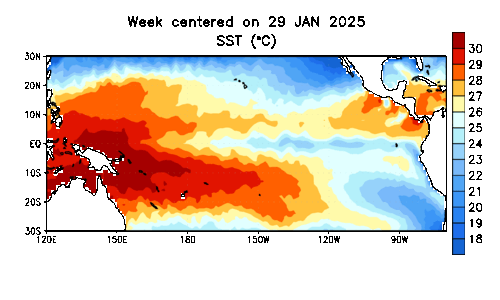 |
 |
| Tropical Pacific sea surface temperatures (left image) and associated anomalies (right image). Click images to enlarge. Images courtesy of the Climate Prediction Center. | |
What is El Niño-Southern Oscillation (ENSO)?
Note: Most of the information in this article is courtesy of climate.gov.
The El Niño-Southern Oscillation (ENSO) is a recurring climate pattern involving changes in the temperature of waters in the central and eastern tropical Pacific Ocean. On periods ranging from about three to seven years, the surface waters across a large swath of the tropical Pacific Ocean warm or cool by anywhere from 1°C to 3°C, compared to normal.
This oscillating warming and cooling pattern, referred to as the ENSO cycle, directly affects rainfall distribution in the tropics and can have a strong influence on weather across the United States and other parts of the world. El Niño and La Niña are the extreme phases of the ENSO cycle; between these two phases is a third phase called ENSO-neutral.
|
Maps of sea surface temperature anomaly in the Pacific Ocean during a strong La Niña (top, December 1988) and a strong El Niño (bottom, December 1997). Maps by NOAA Climate.gov. |
ENSO is one of the most important climate phenomena on Earth due to its ability to change the global atmospheric circulation, which in turn, influences temperature and precipitation across the globe. We also focus on ENSO because we can often predict its arrival many seasons in advance of its strongest impacts on weather and climate.
So, by now, you might have noticed that while “ENSO” is a nice catchall acronym for all three states, that acronym doesn’t actually have the word La Niña in it. Why is that? Well, that is a fluke of history. Before La Niña was even recognized, South American fisherman noticed the warm up of coastal waters occurred every so often around Christmas. They referred to the warming as “El Niño,” (niño being Spanish for a boy child) in connection with the Christmas holiday.
Sir Gilbert Walker discovered the “Southern Oscillation,” or large-scale changes in sea level pressure across Indonesia and the tropical Pacific. However, he did not recognize that it was linked to changes in the Pacific Ocean or El Niño. It wasn’t until the late 1960s that Jacob Bjerknes and others realized that the changes in the ocean and the atmosphere were connected and the hybrid term “ENSO” was born. It wasn’t until the 1980s or later that the terms La Niña and Neutral gained prominence.
.png) |
| Typical winter impacts associated with ENSO neutral events. Colder probabilities are favored across north-central and northeast portions of the US, due to a polar jet stream shifted further south. Meanwhile, warmer probabilities are favored across ths southern US, with above normal precipitation favored across portions of the southeast US. Image courtesy of Ray Wolf, National Weather Serivce. |
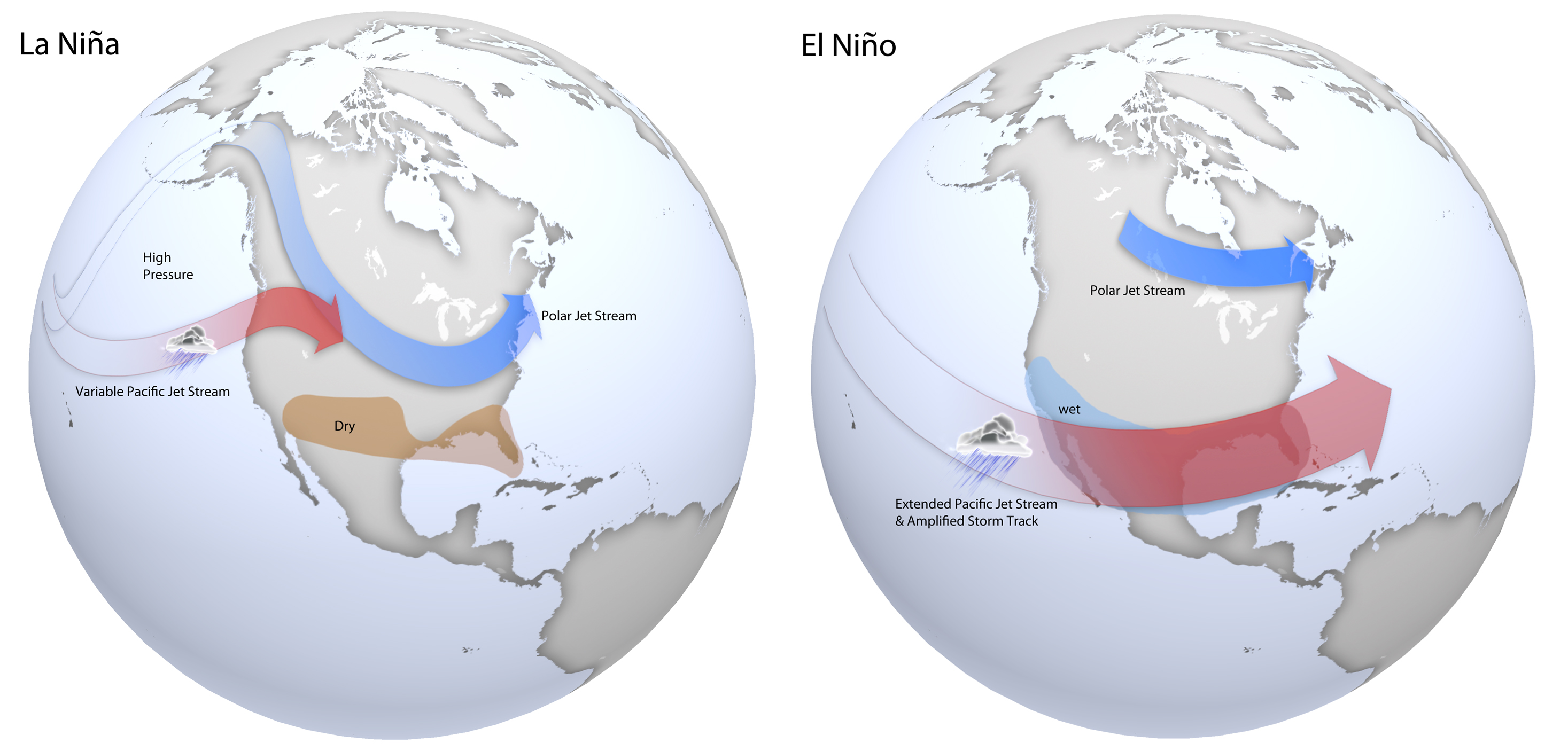 |
| Typical late fall through early spring upper level jet stream positions associated with moderate to strong La Niña (left) and El Niño (right) events. During La Niña, a variable Pacific jet stream in association with a polar jet stream shifted further south favors below normal precipitation across the southern US, with below normal temperatures across the northern US. During El Niño, a strong and amplified Pacific jet stream extending across the southern US in association with a polar jet stream shifted further north into Canada favors above normal precipitation across the southern US, and above normal temperatures over the northern US. Based on original graphics from NOAA’s Climate Prediction Center. |
El Niño Temperature/Precipitation Anomalies
Below are winter (November-March) and summer (May-September) temperature and precipitation anomalies for El Niño episodes since 1950, courtesy of NOAA's Earth System Research Laboratory (ESRL). The anomalies are based 1971-2000 and 1981-2010 normals. These composites are not intended to be a forecast of expected conditions. Rather, they use historical data to highlight locations where ENSO can potentially impact temperature and precipitation. Other climate and weather processes along with atmospheric variability may make the impacts of one ENSO event different than another. Some events may be associated with very extreme climate conditions which may dominate the composites.
The below composites suggest slightly warmer than normal temperatures are favored across northeast Kansas during winter, with near normal temperature elsewhere. Slightly cooler than normal temperatures are favored over northwest Kansas during summer, with near normal temperatures elsewhere. Meanwhile, near to slightly above normal precipitation is favored across much of the state during winter and over northwest Kansas during summer, with near normal precipitation elsewhere.
| Winter (Nov-Mar) Temperature | Summer (May-Sept) Temperature |
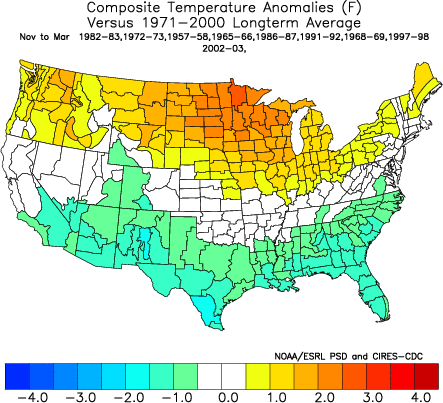 |
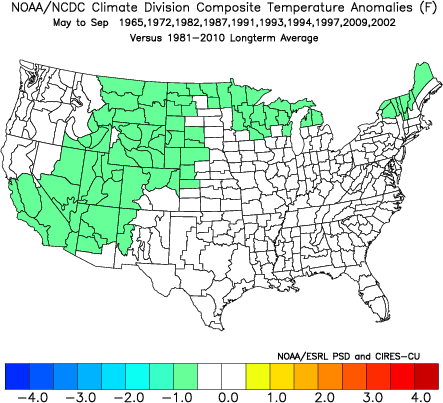 |
| Winter (Nov-Mar) Precipitation | Summer (May-Sept) Precipitation |
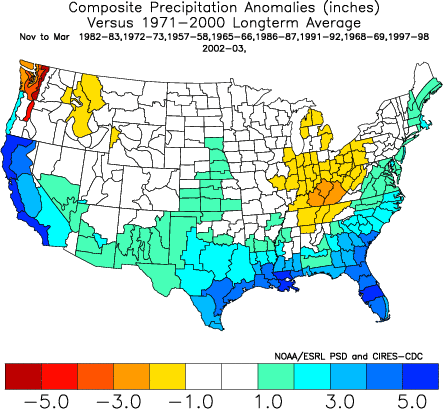 |
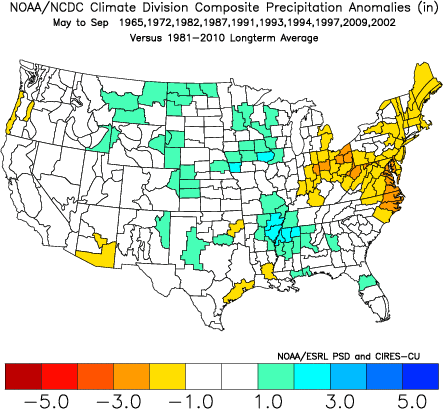 |
La Niña Temperature/Precipitation Anomalies
Below are winter (November-March) and summer (May-September) temperature and precipitation anomalies for La Niña episodes since 1950, courtesy of NOAA's Earth System Research Laboratory (ESRL). The anomalies are based 1971-2000 normals. These composites are not intended to be a forecast of expected conditions. Rather, they use historical data to highlight locations where ENSO can potentially impact temperature and precipitation. Other climate and weather processes along with atmospheric variability may make the impacts of one ENSO event different than another. Some events may be associated with very extreme climate conditions which may dominate the composites.
The below composites suggest near to above normal temperatures are favored across Kansas during winter and summer months. Meanwhile, below normal precipitation is favored across much of the state during the winter and summer months.
| Winter (Nov-Mar) Temperature | Summer (May-Sept) Temperature |
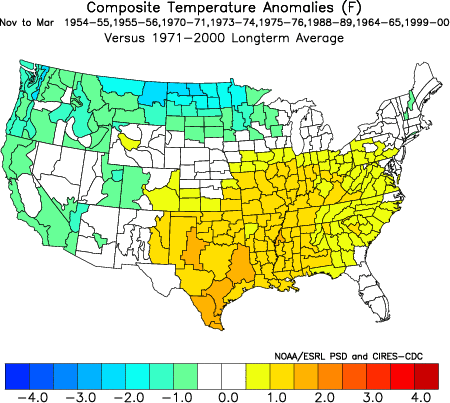 |
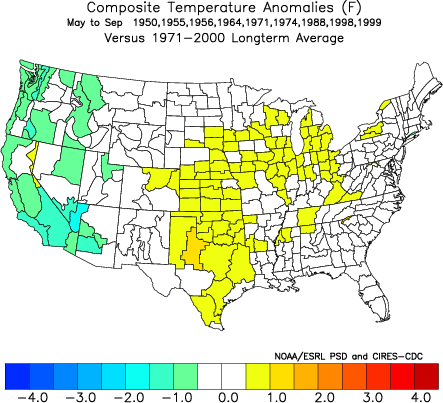 |
| Winter (Nov-Mar) Precipitation | Summer (May-Sept) Precipitation |
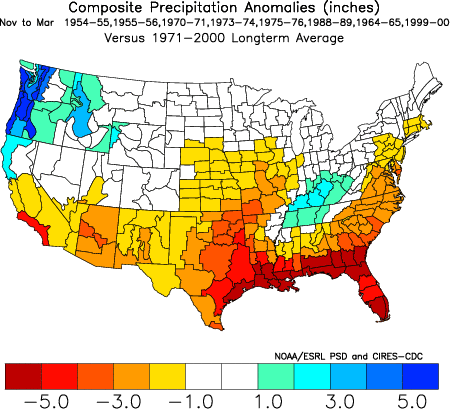 |
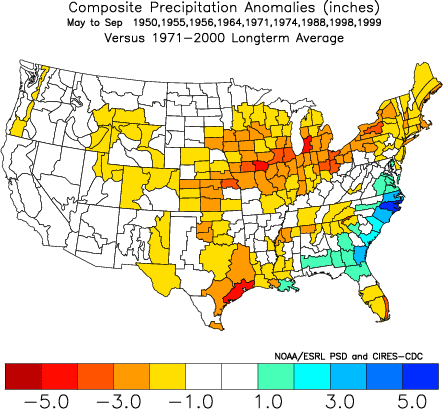 |
El Niño: Risk of Weather Extremes
The images below depict the odds of extreme wet/dry or warm/cold three-month periods associated with historical El Niño episodes since 1950. Extreme weather is defined as being in the highest or lowest 20% of the 100 year record. The climatological average risk of extreme weather any given season is 20%. These composites are not intended to be a forecast of expected conditions. Rather, they use historical data to highlight locations where ENSO can potentially impact temperature and precipitation.
El Niño: Risk of Temperature Extremes
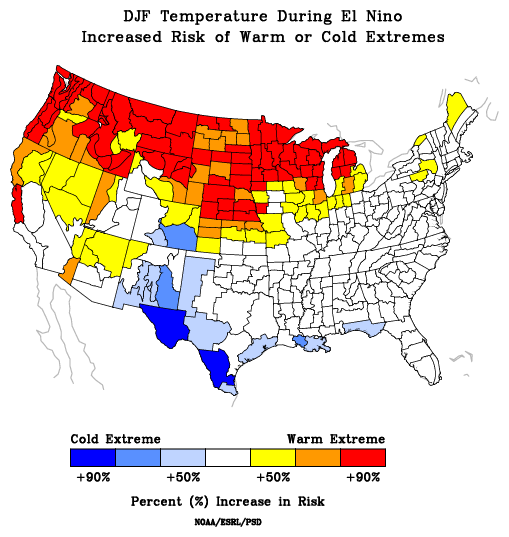 |
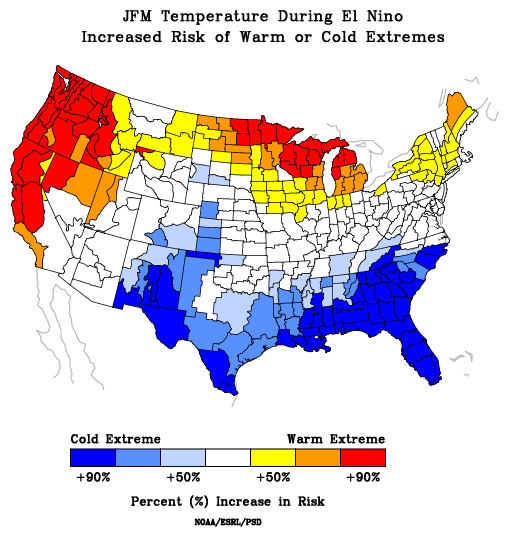 |
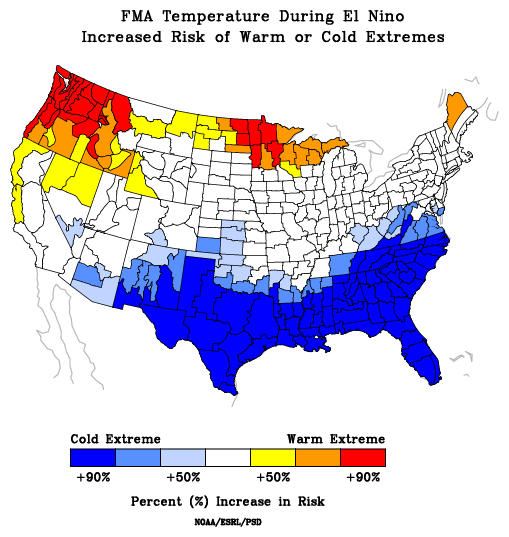 |
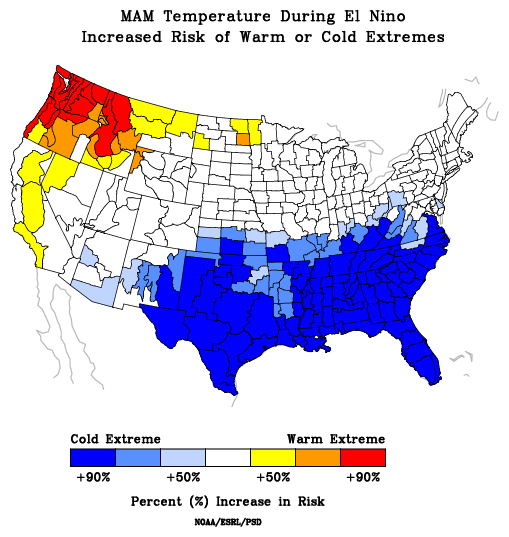 |
| December - February | January - March | February - April | March - May |
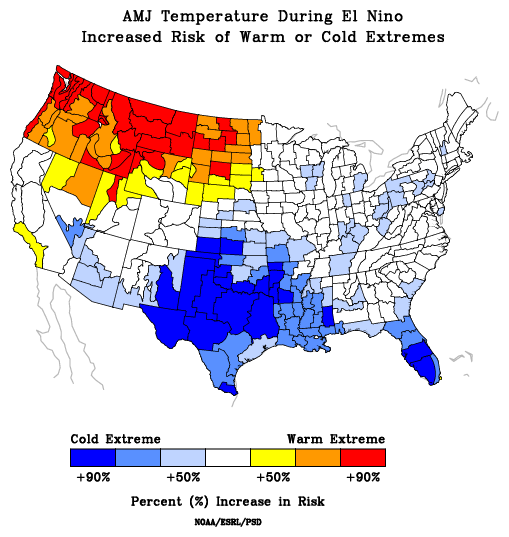 |
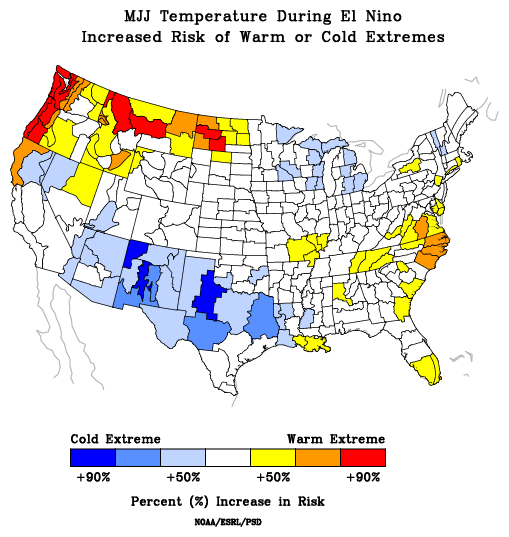 |
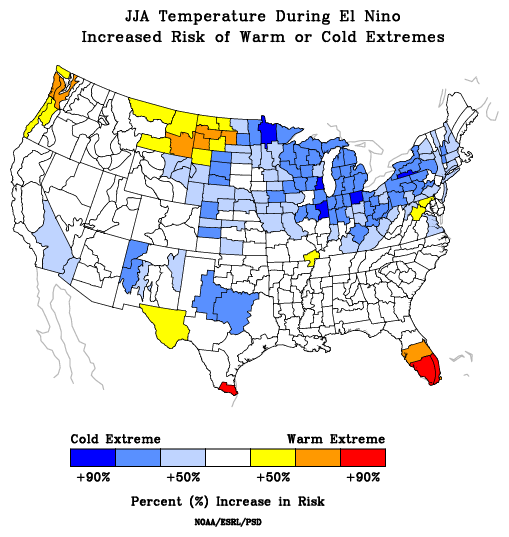 |
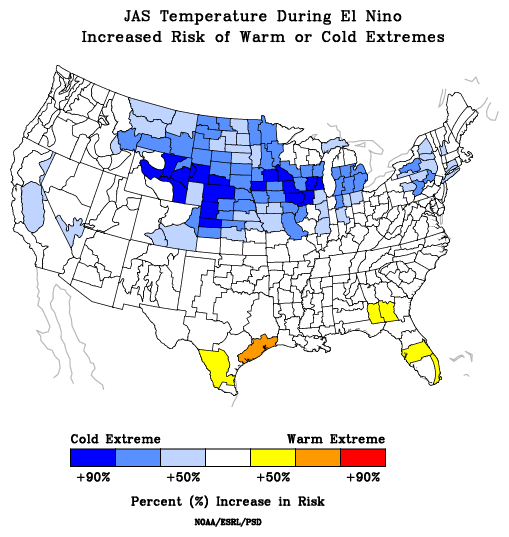 |
| April - June | May - July | June - August | July - September |
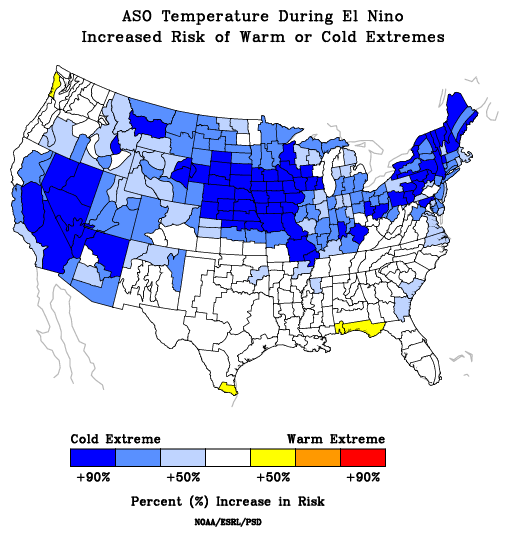 |
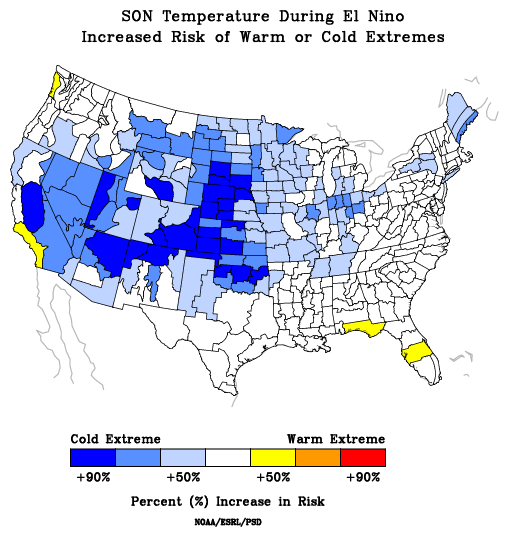 |
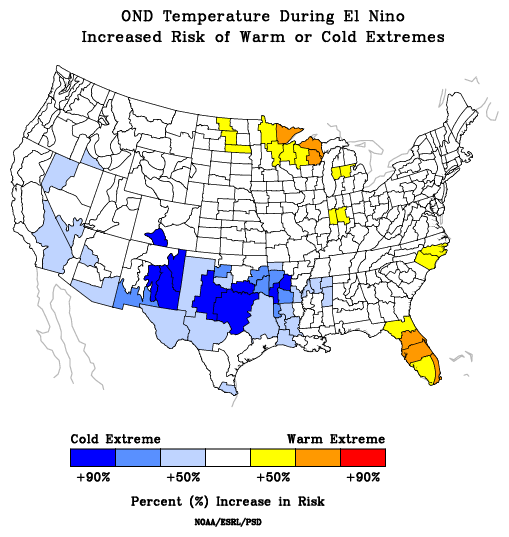 |
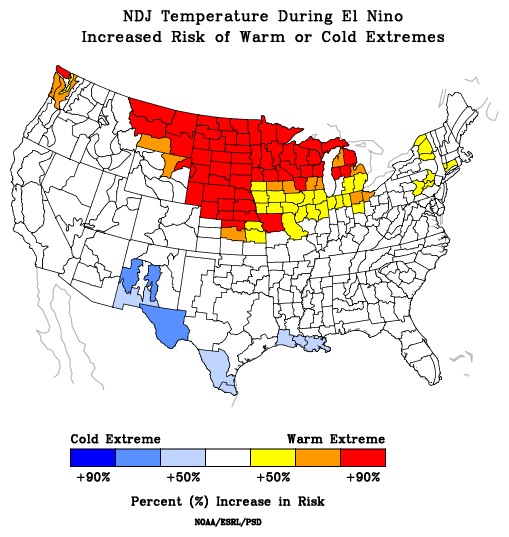 |
| August - October | September - November | October - December | November - January |
The above images depict chances of extreme warm or cold three-month periods associated with past El Niño's since 1950. Warm colors indicate an increased risk of warm temperature extremes, while cool colors indicate an increased risk of cold temperature extremes. With the exception of late fall through early winter, the risk of cool temperature extremes exists much of the year across Kansas. Click each image to enlarge. Images courtesy of NOAA's Earth System Research Laboratory.
El Niño: Risk of Precipitation Extremes
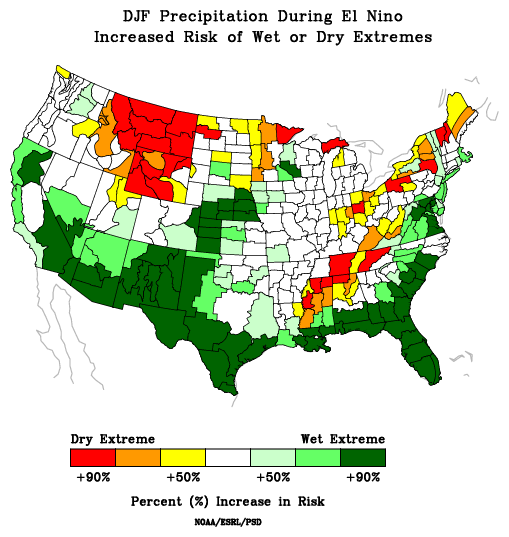 |
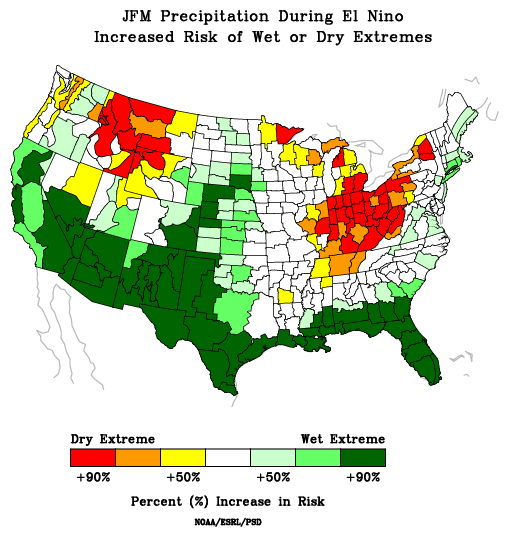 |
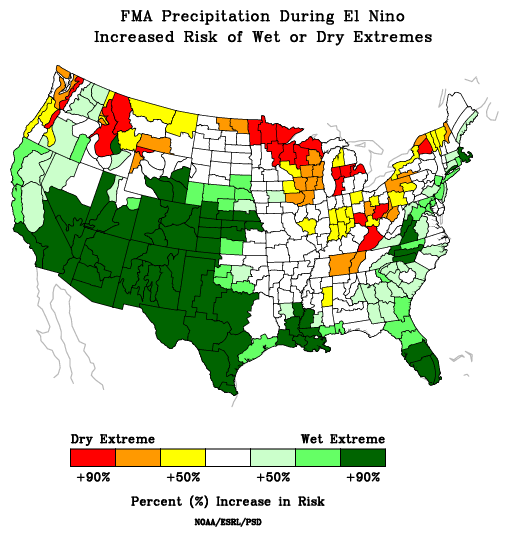 |
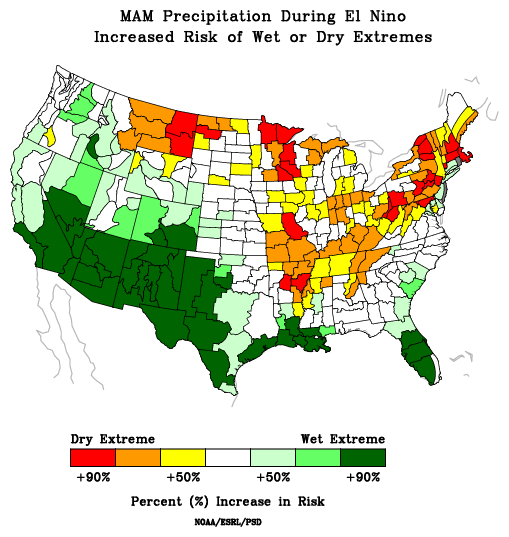 |
| December - February | January - March | February - April | March - May |
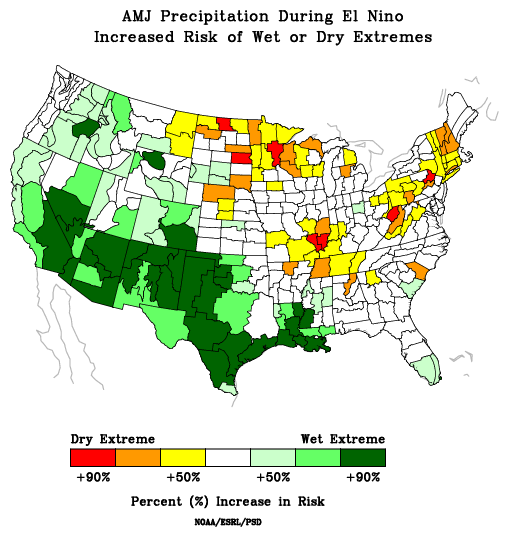 |
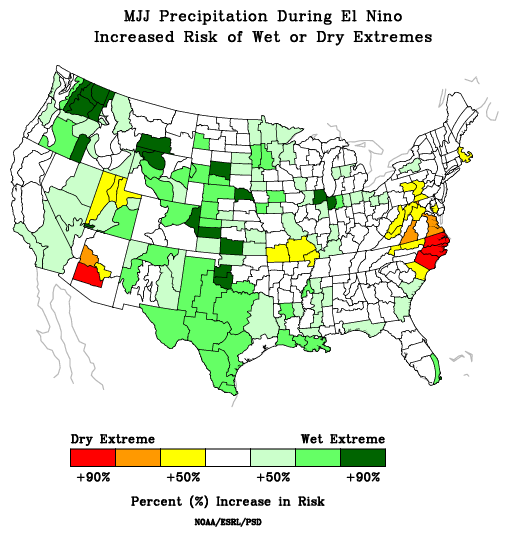 |
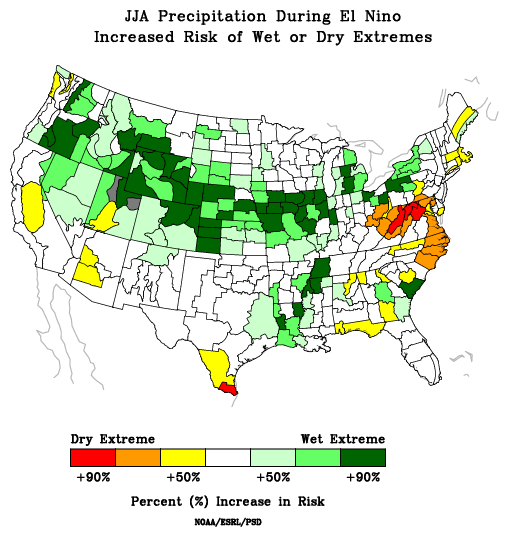 |
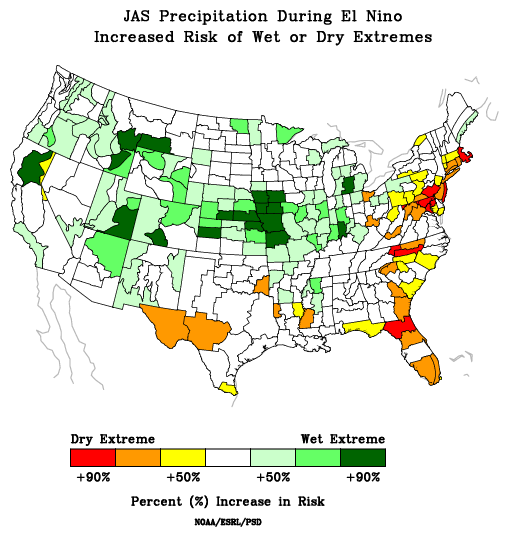 |
| April - June | May - July | June - August | July - September |
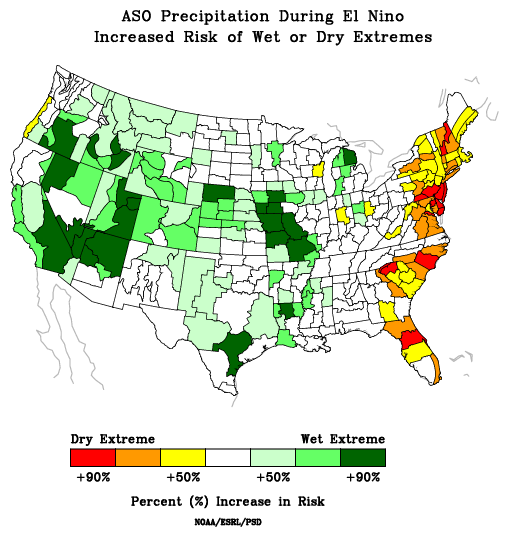 |
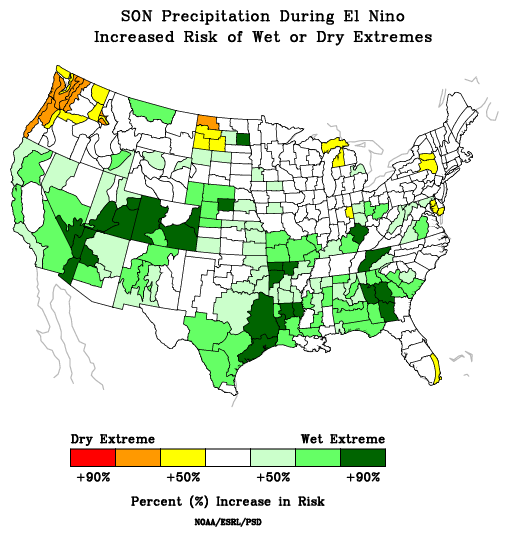 |
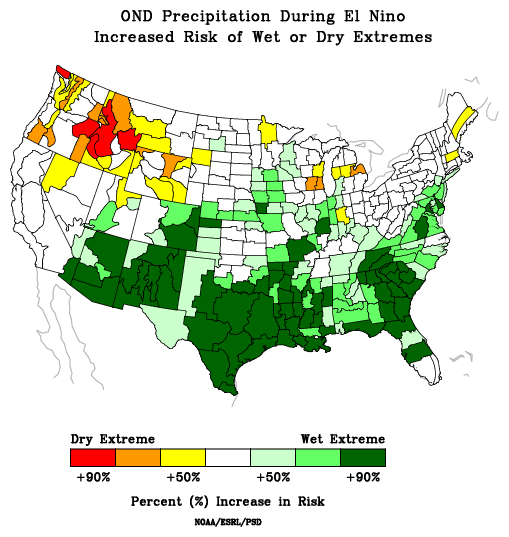 |
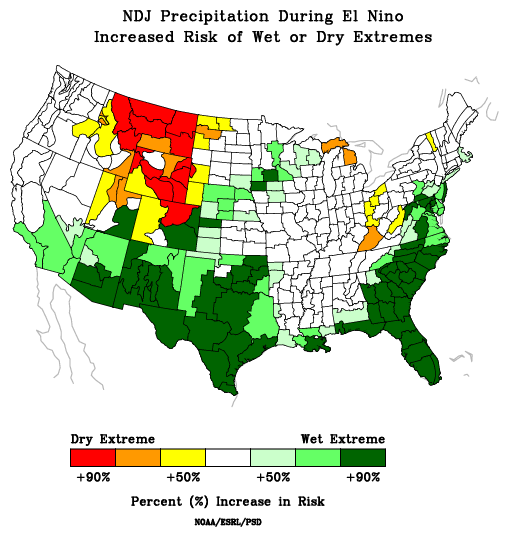 |
| August - October | September - November | October - December | November - January |
La Niña: Risk of Weather Extremes
The images below depict the odds of extreme wet/dry or warm/cold three-month periods associated with historical La Niña episodes since 1950. Extreme weather is defined as being in the highest or lowest 20% of the 100 year record. The climatological average risk of extreme weather any given season is 20%. These composites are not intended to be a forecast of expected conditions. Rather, they use historical data to highlight locations where ENSO can potentially impact temperature and precipitation.
La Niña: Risk of Temperature Extremes
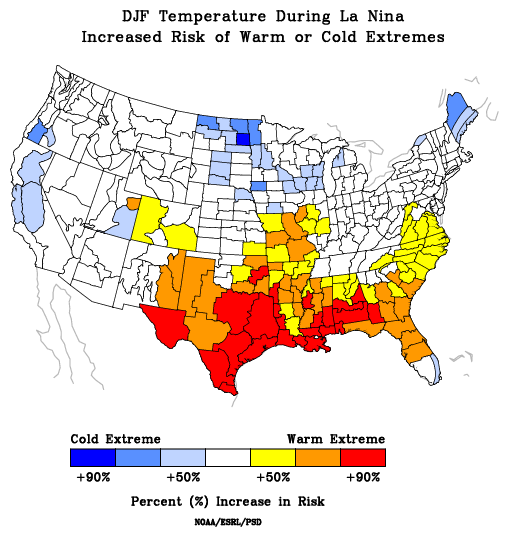 |
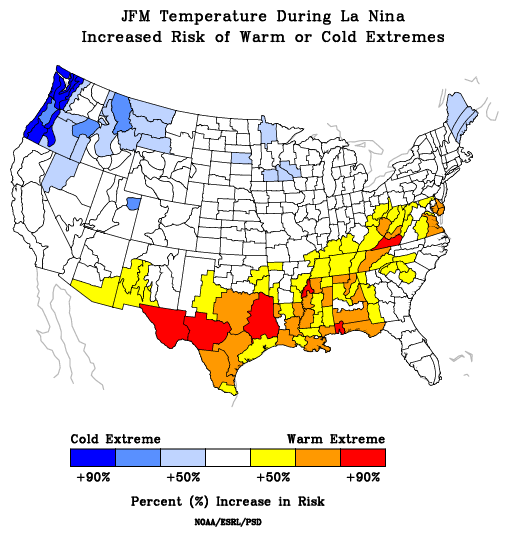 |
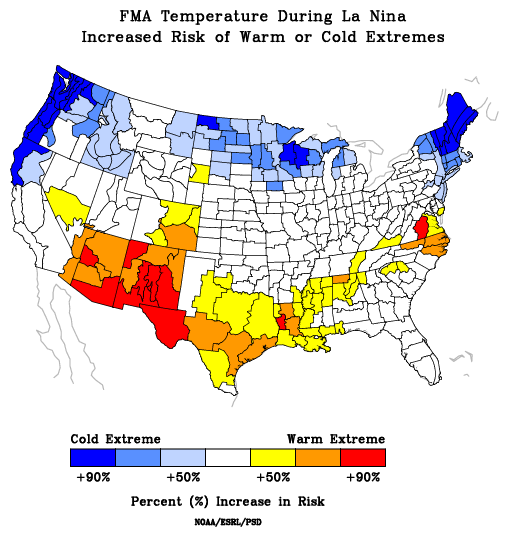 |
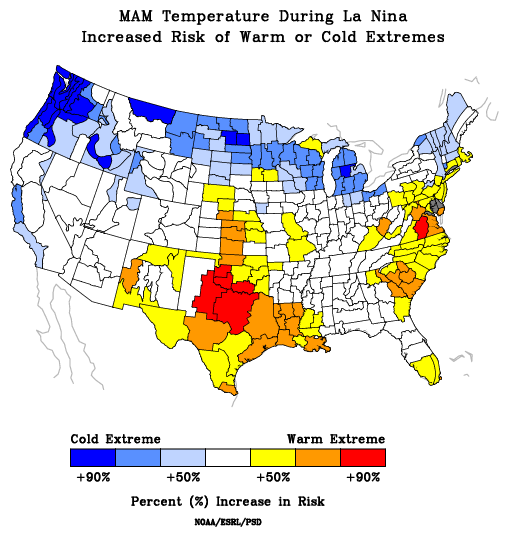 |
| December - February | January - March | February - April | March - May |
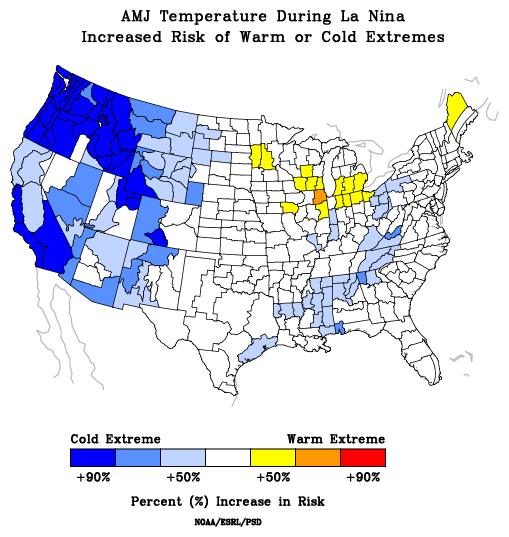 |
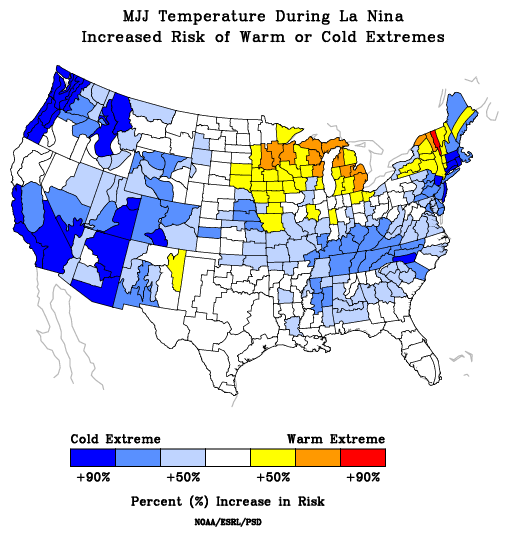 |
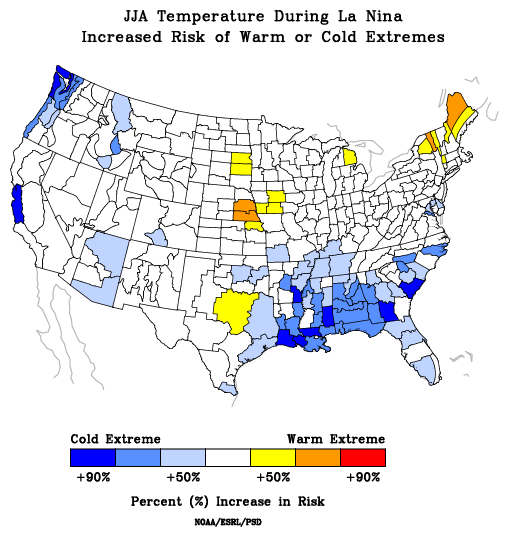 |
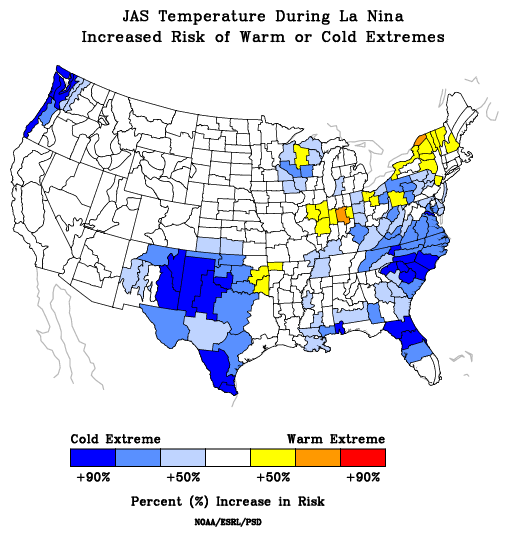 |
| April - June | May - July | June - August | July - September |
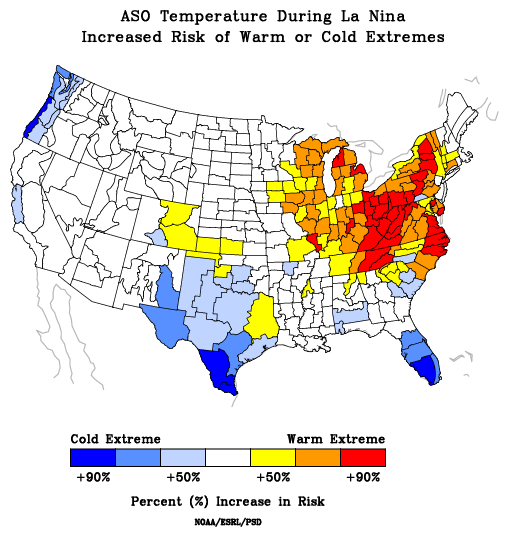 |
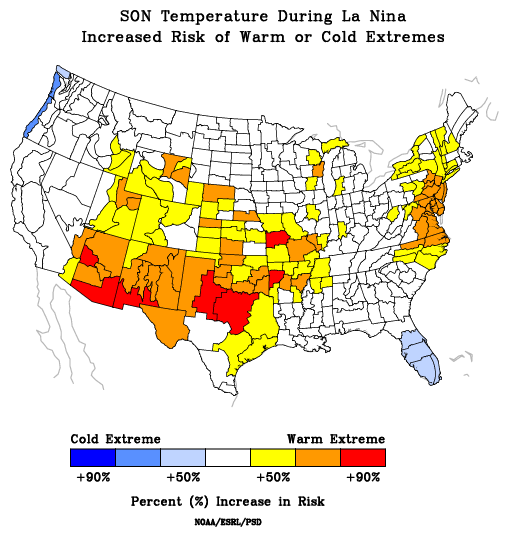 |
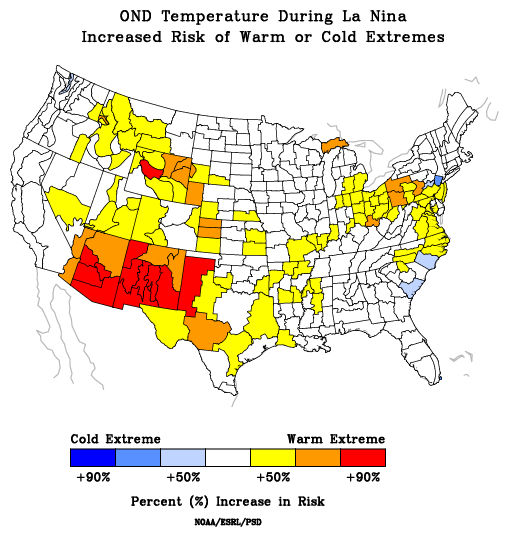 |
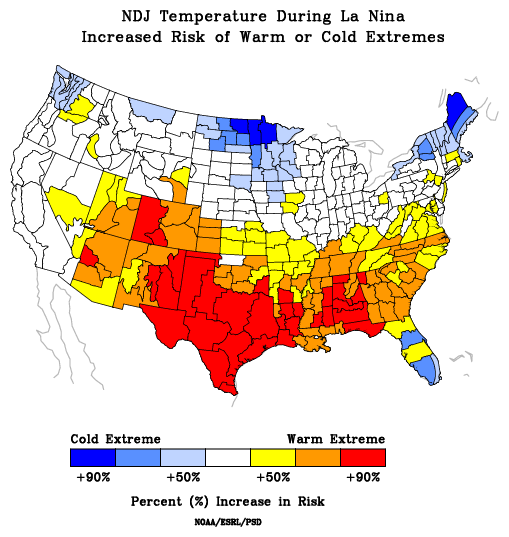 |
| August - October | September - November | October - December | November - January |
The above images depict chances of extreme warm or cold three-month periods associated with past La Niña's since 1950. Warm colors indicate an increased risk of warm temperature extremes, while cool colors indicate an increased risk of cold temperature extremes. In general, there is an increased risk of warm temperature extremes fall and winter across Kansas, with an increased risk of cool temperature extremes during the summer. Click each image to enlarge. Images courtesy of NOAA's Earth System Research Laboratory.
La Niña: Risk of Precipitation Extremes
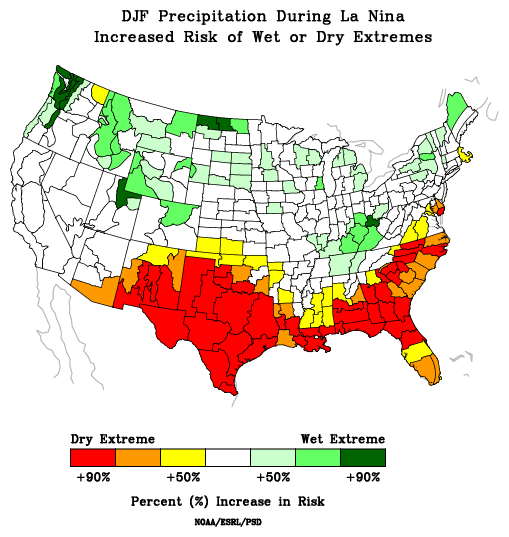 |
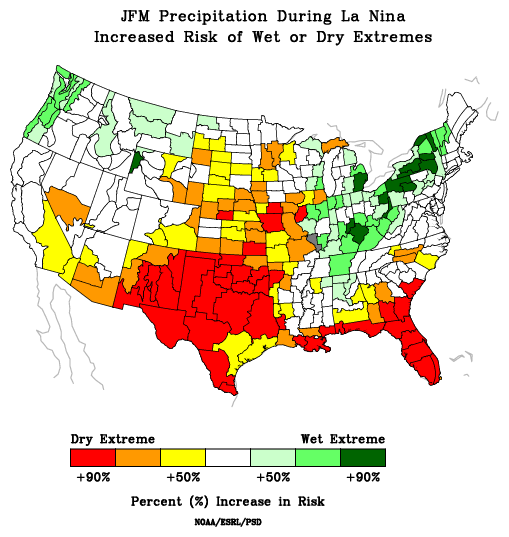 |
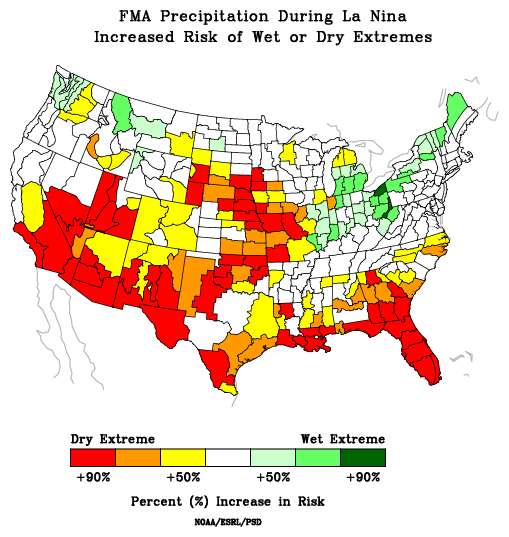 |
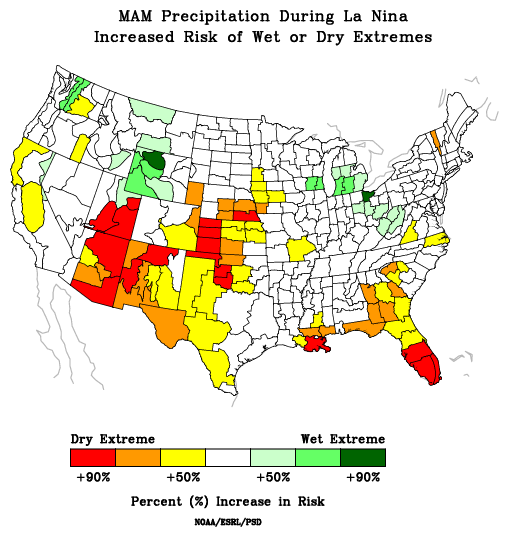 |
| December - February | January - March | February - April | March - May |
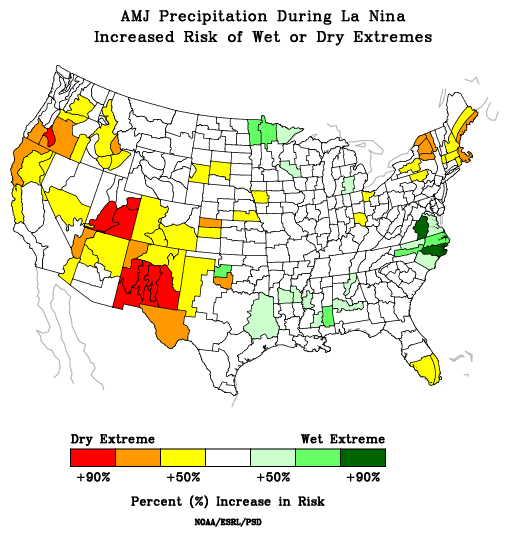 |
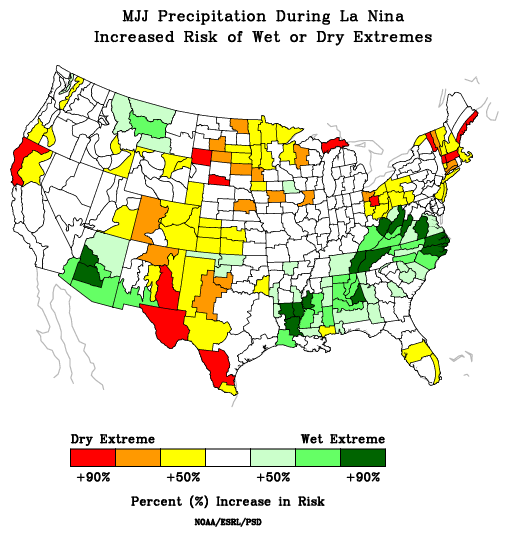 |
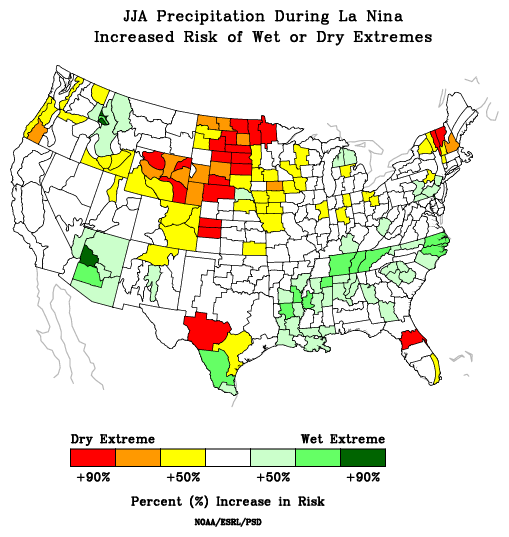 |
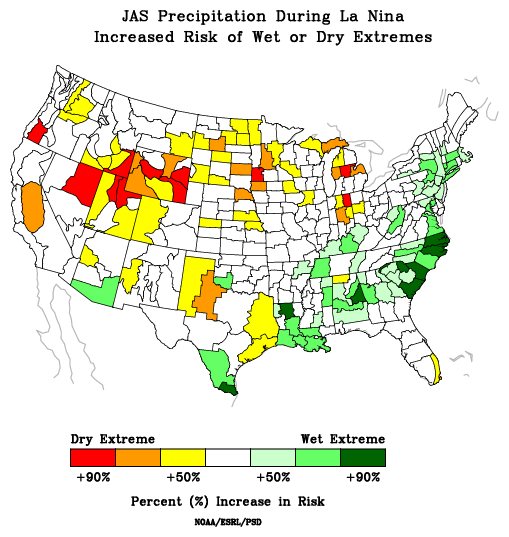 |
| April - June | May - July | June - August | July - September |
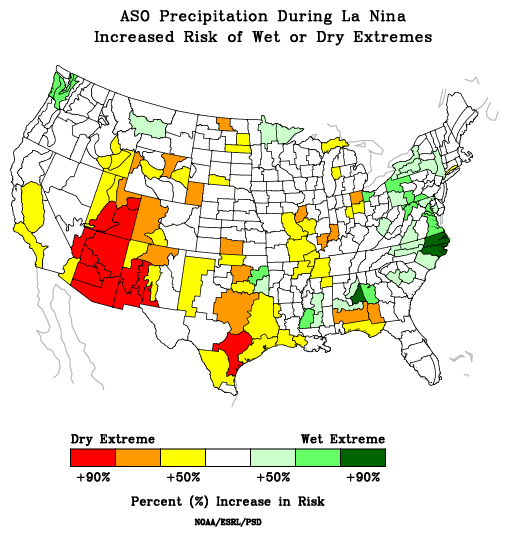 |
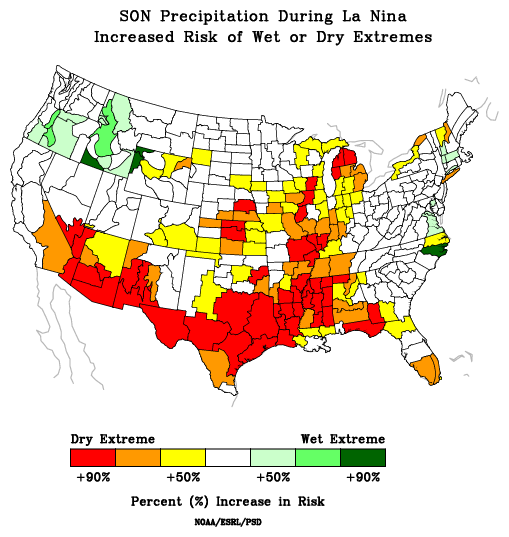 |
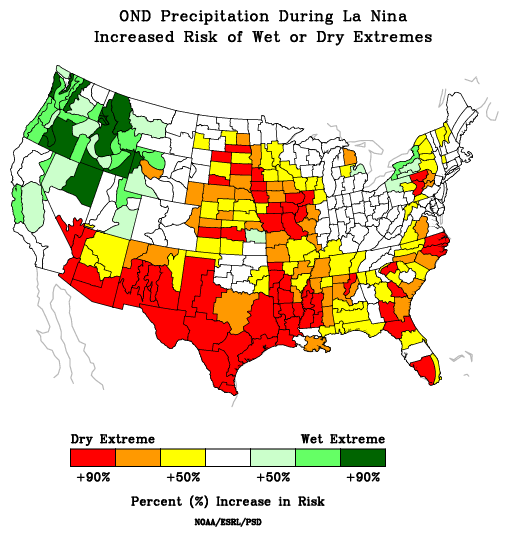 |
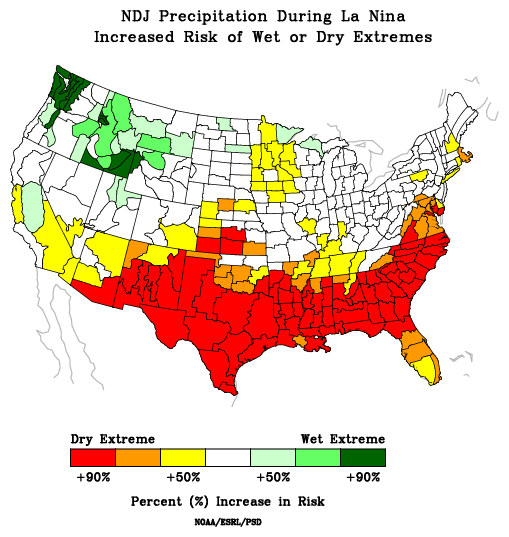 |
| August - October | September - November | October - December | November - January |
The above images depict chances of extreme wet or dry three-month periods associated with past La Niña's since 1950. Warm colors indicate an increased risk of dry precipitation extremes, while green colors indicate an increased risk of wet precipitation extremes. Other than a few exceptions, there is generally an increased risk of dry precipitation extremes across Kansas throughout the year. Click each image to enlarge. Images courtesy of NOAA's Earth System Research Laboratory.
Agricultural Impacts
The following images show historical ENSO impacts on corn yield across the Heartland. Unfortunately, impacts are unavailable for crops other than corn at this time. These composites are not intended to be a forecast of expected yields. Rather, they use historical data (1981-2010) to highlight locations where ENSO can potentially impact climate conditions and associated corn yields to help you make more informed farm management decisions. Images courtesy of Useful to Useable (U2U).
El Niño
 |
| Corn Yield Departure from Normal |
Historical corn yields (left) and corn yield departure from normal (right) for El Niño years since 1981. Green colors on the "departure from normal" image depict above normal yields, while brown colors indicate below normal yields. Click images to enlarge. Images courtesy of Useful to Useable (U2U).
La Niña
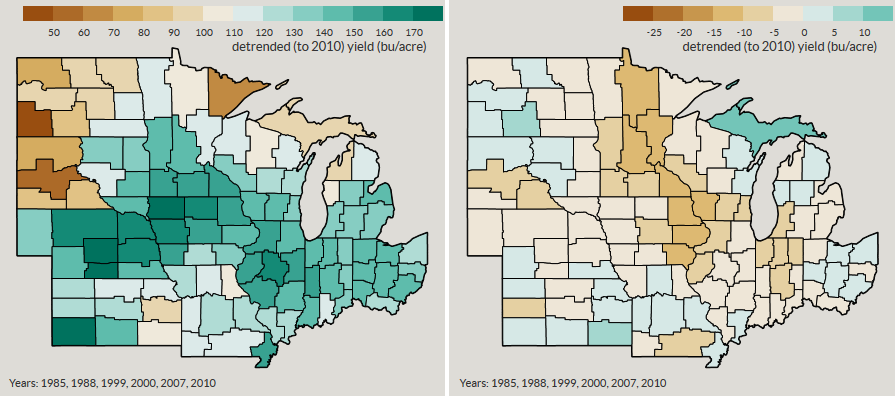 |
| Corn Yield Departure from Normal |
Historical corn yields (left) and corn yield departure from normal (right) for La Niña years since 1981. Green colors on the "departure from normal" image depict above normal yields, while brown colors indicate below normal yields. Click images to enlarge. Images courtesy of Useful to Useable (U2U).
Neutral
 |
| Corn Yield Departure from Normal |
Historical corn yields (left) and corn yield departure from normal (right) for ENSO neutral years since 1981. Green colors on the "departure from normal" image depict above normal yields, while brown colors indicate below normal yields. Click images to enlarge. Images courtesy of Useful to Useable (U2U).
Official Long-Range Forecasts
The below long-range outlooks are courtesy of the Climate Prediction Center (CPC). They indicate probabilities of above, near or below normal temperature/precipitation for the given time period. They do NOT represent the expected magnitude of warm/cool and/or wet/dry weather. Professionals at CPC take into account many different factors when assembling these forecasts, including the ENSO composites posted throughout this report. Click images to enlarge.
One-Month Forecast
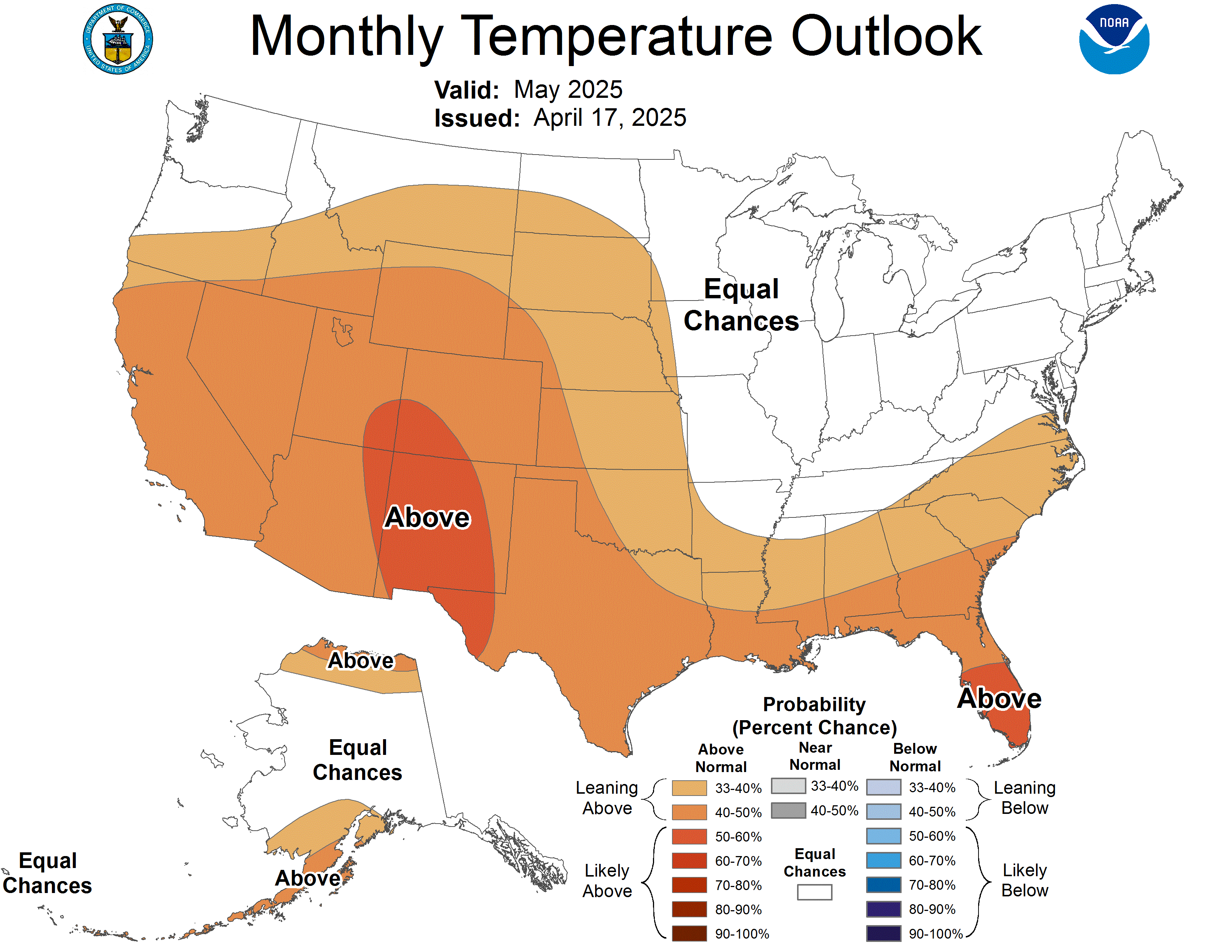 |
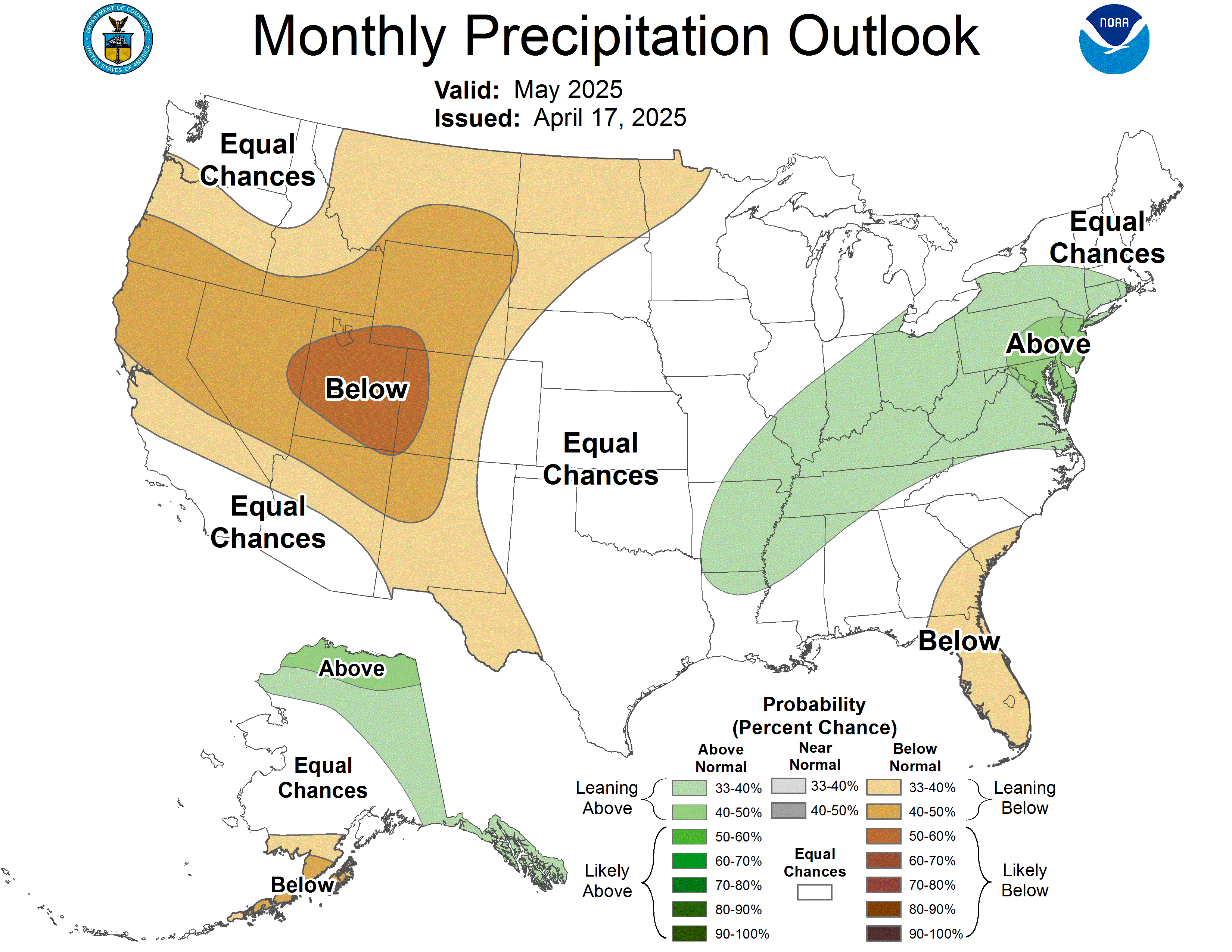 |
| Above/Below Normal Temperature Probabilities | Above/Below Normal Precipitation Probabilities |
Three-Month Forecast
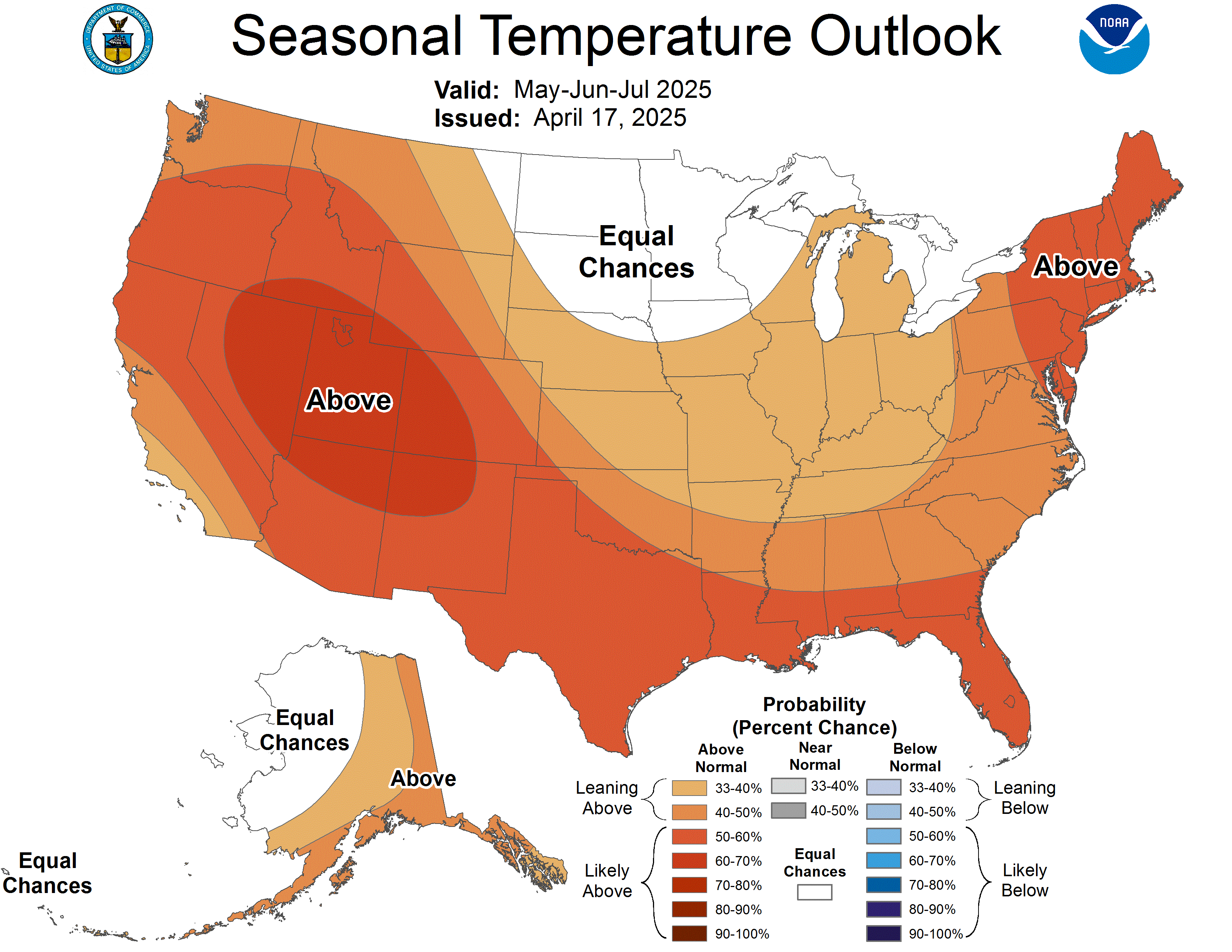 |
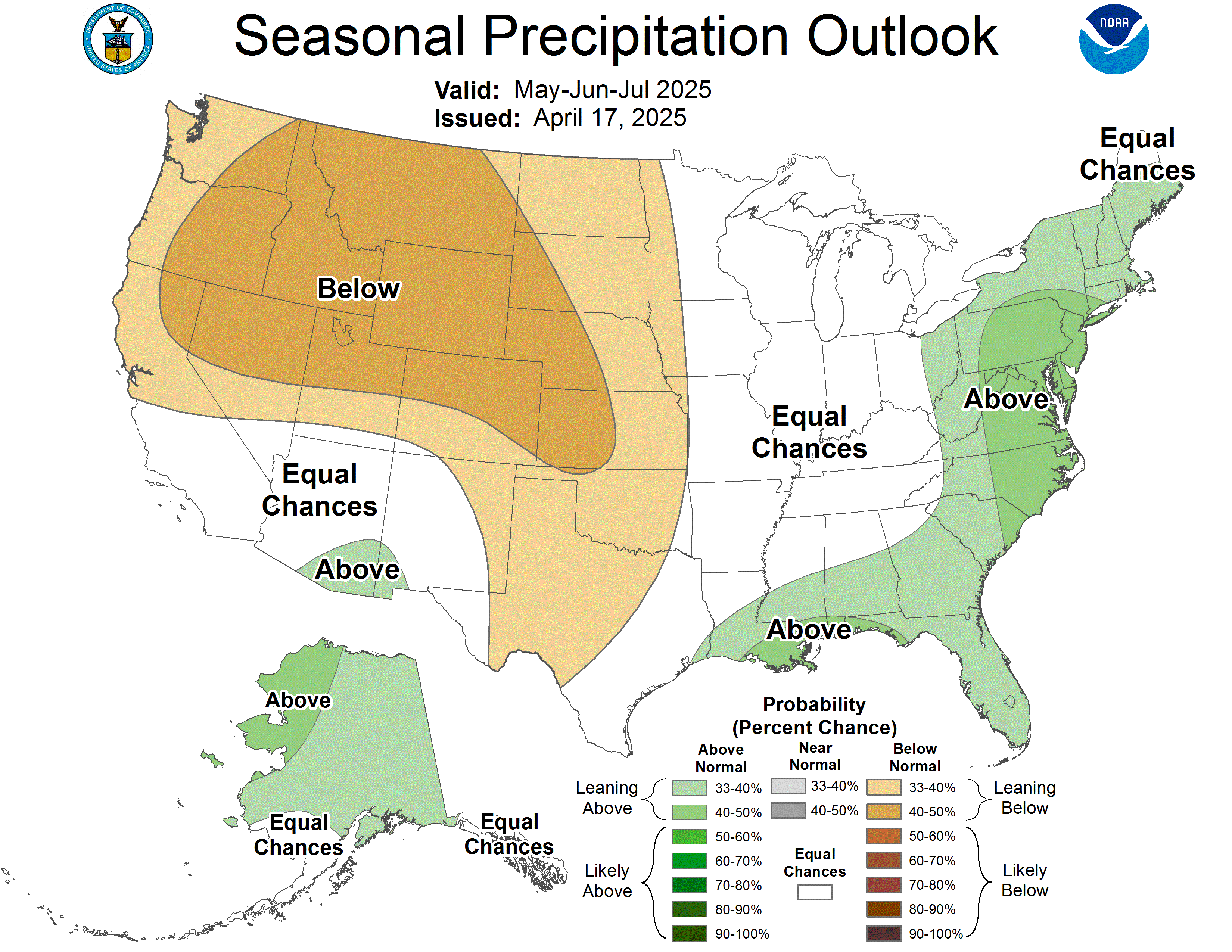 |
| Above/Below Normal Temperature Probabilities | Above/Below Normal Precipitation Probabilities |
ENSO & Spring Severe Thunderstorm Frequency
A paper published in Nature Geoscience in April 2015 by John Allen, Michael Tippett, and Adam Sobel examines the influence of El Niño/La Niña on springtime hailstorms and tornadoes across the contiguous United States from late winter through spring. The below images are adapted from the paper, and show tornado and hail frequencies for the spring months (March-May) during El Niño (left column) and La Niña (right column). The authors explain that the connection between El Niño/La Niña conditions and summertime storms is less clear, and unfortunately that is the time of year when severe storms peak throughout much of the United States. But for springtime, at least, El Niño/La Niña data may be able to refine seasonal severe weather outlooks. These composites are not intended to be a forecast of expected conditions. Rather, they use historical data to highlight locations where ENSO can potentially impact spring severe weather.
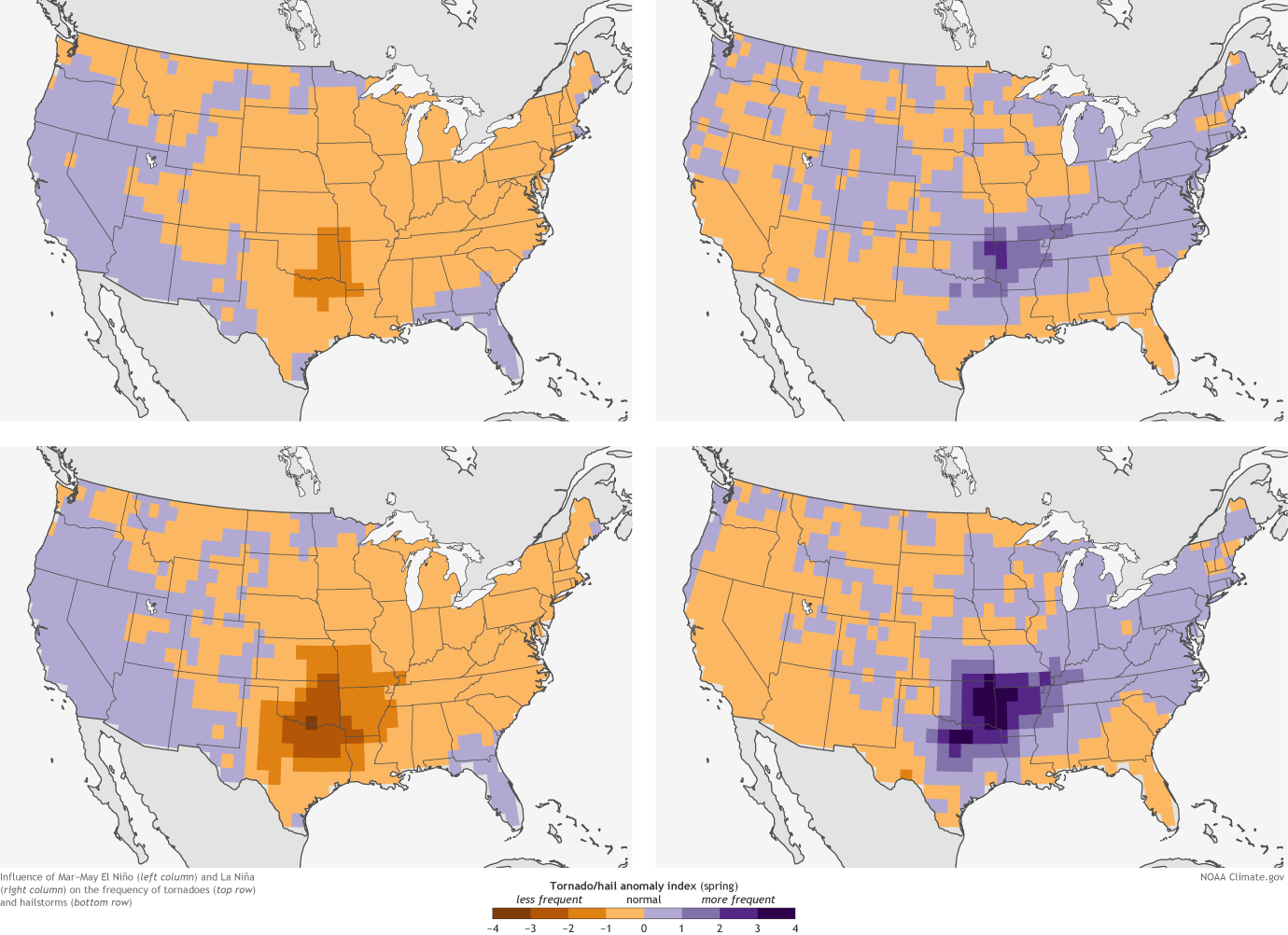 |
| Tornado and hail frequencies for the spring months (March-May) during El Niño (left column) and La Niña (right column). Purple favors higher storm event frequency, and brown favors lower storm event frequency. Specifics vary, but in general, springtime tornadoes and hailstorms are less frequent in the central and southern United States during El Niño, and more frequent during La Niña. Image courtesy of NOAA climate.gov. |
Additional Links/Resources